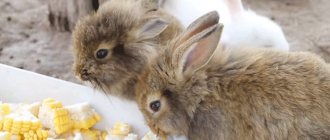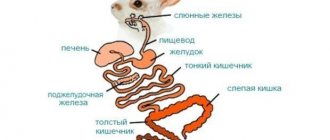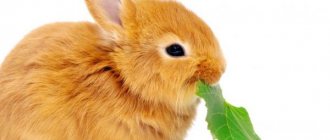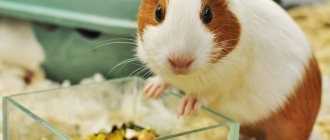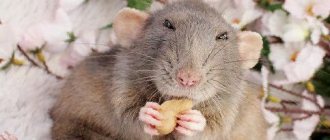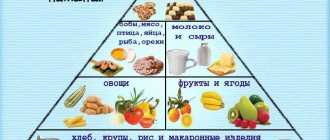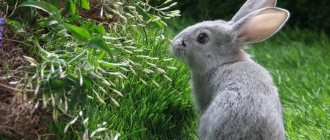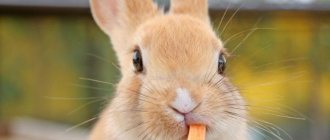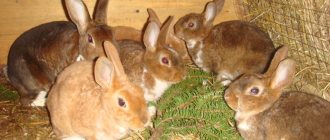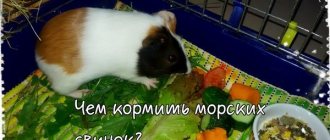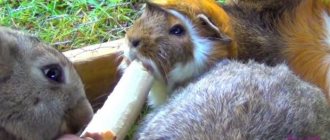Owners of rabbit farms are interested in the question of whether rabbits can eat peas. Many people grow this crop in their gardens; it can be a good help for farmers. From this article, readers will learn at what age it is allowed to introduce peas into the diet of long-eared animals, whether tops and pods can be given, and how to properly feed animals with such food.
Feeding the rabbit peas
Can rabbits be given peas?
Experienced rabbit breeders are confident that these animals simply need to supplement their diet with legumes, the most accessible and popular of which is peas.
This type of food is rich in:
- vegetable protein;
- B vitamins;
- minerals, of which there are more than 20;
- amino acids;
- organic substances.
The consumption of this representative of legumes by rabbits saturates their body with proteins that help build muscle mass, that is, the desired meat, and supplies it with vitamins, minerals and amino acids that stimulate the growth and strengthening of the immune system of these gentle creatures.
All these pea nutrients are especially valuable for pregnant and lactating females. However, with all its valuable nutritional qualities, this type of food can in no case act as the main one, but can only serve as an addition to the rabbit diet.
Excessive consumption inevitably leads to disruption of the functioning of the gastrointestinal tract and most often manifests itself in bloating due to the active production of gases. This is especially true for decorative and dwarf rabbits, which is why it is recommended that they be given this legume no more than once a week.
Feeding rules
Most experts believe that rabbits can be given peas from the age of one month, but some argue that this should not be done until the animals are seven months old.
This product can be included in the rabbit diet in three forms:
- fresh;
- dried;
- as tops and pods.
Depending on the type of pea product, the method of feeding it to rabbits also varies. For example, a fresh product, fresh from the garden, cannot be given to animals right away.
It must first be exposed to air, then turned into a pulp and added to the main feed. Tops and pods are also given not fresh, but in dried or dried form.
Dry peas
This dried legume product should not be given to animals without pre-treatment.
To do this it should:
- Rinse well.
- Pour boiling water over it.
- Add table salt to it at the rate of half a tablespoon for every liter of water.
- Leave to swell for two hours.
- Swollen peas can be mixed with grated sugar beets, carrots, bran or silage.
Steamed peas
It is also recommended to steam dried green peas.
For this:
- Double the volume of boiling water is added to a certain volume of product.
- For every three liters of boiling water, add 20 grams of table salt.
- The peas swell for two hours.
- The swollen product is pureed and added to feed or grain products.
Video: feeding rabbits with peas
A hodgepodge of leftovers from the kitchen table.
We collect everything that is left over from cooking into a large saucepan. These can be potato and beetroot and carrot peelings, outer cabbage leaves, onion peels... We cook all this, add feed or bran, close tightly for steaming.
Subscribe to our website's weekly newsletters: Current notes on keeping rabbits are waiting for you.
SUBSCRIBE
Although rabbits do not particularly respect fatty foods, being herbivores, they still will not mind if you add some leftover low-fat soup or, for example, broth after cooking dumplings to the mash. Salt is not used in this case. After mixing, it can be distributed into feeders, or briquettes the size of a chicken egg can be formed and dried in an oven for further use. Excess briquettes can be frozen and dispensed as needed.
What else can you give rabbits?
In addition to peas, these animals happily eat other legumes in the form of:
- beans;
- lentils;
- soy;
- beans
An extremely nutritious product that promotes the rapid and high-quality growth of rabbits, peas also have their downside, in which excessive consumption can cause harm to animals, even incompatible with life.
Rabbits are kept mainly to produce tender and nutritious meat, as well as for fur purposes. To quickly increase body weight and improve the quality of hair, they need a varied and balanced diet. After all, food is the main source of energy and the key to a strong immune system. The question, often encountered among livestock breeders, is whether rabbits can eat peas and other legumes, often remains without an appropriate answer. Although opinions on this matter differ, every farmer must take into account all the benefits of these products, as well as the correct feeding of them in order to get a positive result.
Composition of a proper diet
Before giving legumes, including peas, to rabbits, it is necessary to know not only the genetic features of the structure of the animal’s body, but also the composition of the product. This is required in order to assess the benefits or harm that a rabbit may receive when eating a certain type of food.
Rabbit breeding has long been characterized by fairly stringent requirements for food standards, balance and composition. In order for animals to grow successfully, be less exposed to various diseases and have high sexual productivity, their diet must be varied. This is the main rule in feeding rabbits. The combination of green grass, grain, root vegetables, fruits, legumes, mixed feed, hay, silage, as well as various vitamin supplements, is the key to the correct and effective cultivation of these animals.
Advice! Most food for rabbits must have a coarse structure, which is necessary for grinding down constantly growing teeth.
Animals constantly have to chew on something, and in addition to their main food, they are given thin branches of some trees, such as cherry or acacia. Another important point in feeding is the drying of succulent grass (at least a day in a dark place) and other types of food that contain a lot of liquid. In addition, when feeding roughage, you should monitor the purity of the water for the animals, which is given and changed every day. If you neglect this rule of care, you can get negative consequences in the form of the development of intestinal infections.
Which hay is better
Unlike straw, hay not only helps rabbits digestion due to its fiber content, but is also highly nutritious. The rabbit itself can help in choosing ingredients for preparations, but a person needs to make sure that the food is varied and enriched with useful substances.
Composition depending on the rabbits' preferences:
- To enrich the feed with vitamin D, rhubarb, dandelion, lupine, burdock, yarrow, plantain, nettle, and wild sorrel are added.
- Alfalfa, clover, and wheatgrass are mixed into the hay for females during the feeding period and for young individuals.
- For a general therapeutic effect - shepherd's purse, wild dill, chicory, rowan.
Storage conditions have a special influence on the quality of food. Do not allow the food to become damp, mold or freeze.
The benefits and harms of legumes
Whether it is possible to give peas to rabbits and what effect it has on the animal’s body should be found out by studying various sources and adopting the knowledge of experienced rabbit breeders. Peas belong to the legume family and contain a lot of protein, lysine and other useful elements. This product is perfectly absorbed and digested, causing a rapid increase in the weight of the animal. But at the same time, it is not recommended to abuse such legume food, since an excess of peas can cause disruption of the intestines, promoting bloating and the formation of gases.
Small rabbits under one month of age cannot be fed with this product at all, since their body is not yet strong and is not able to digest such roughage. After thirty days from birth, you can try giving them a small amount of peas, observing the behavior of the animals. Rabbits should feel well, lead an active lifestyle and not refuse to eat.
Meadow grass
Meadow grasses are considered environmentally friendly; they contain useful elements that are required to maintain the animal’s body. But experienced rabbit breeders recommend stocking up on raw materials in the outback, away from the city and away from contaminated areas.
Rabbits love meadow grass because it is quite tender. It also contains a lot of fiber and proteins, which are easily absorbed by the body. But it is better to harvest it before the first buds appear, at which time its leaves and stems are very tender and juicy.
What grass can you feed rabbits? Let's look at the most useful one:
- This useful herb for rabbits, sainfoin, is suitable for harvesting for the winter. It contains many nutritional components that are required for the full development of eared animals;
- alfalfa. Contains a high level of protein and amino acids. The grass can be given to young individuals and lactating females;
- plantain. The rabbit family will happily consume this plant in fresh or dried form. The composition contains a high content of vitamins and proteins. This is a useful herb for rabbits, which has a positive effect on the development of these animals;
- coltsfoot. The plant ripens early, for this reason it is added to the diet of rabbits as early as May. Coltsfoot has a beneficial effect on the functioning of the digestive system;
- oats A useful plant that rabbits enjoy eating. In the summer, it is sown twice and mowed in June-September;
- young corn. A nutritious plant that is usually mixed with legumes. Improves the functioning of the digestive organs.
Feeding rules
Dry peas or other legumes should make up no more than 10% of the total daily diet. And they can be given mixed with feed and bran, by steaming in water for two hours. You cannot feed rabbits a product that has just been picked from the garden, as well as a ready-made product purchased in a store.
The peas need to be cleared of their pods, allowed to dry a little, and only then can they be offered to animals. When adding fruits to the mixture, it is recommended to crush them and turn them into pulp. The pods and green mass can also be fed to rabbits after drying them for at least 24 hours in a darkened room.
Advice! Peas should be included in lunch feeding for better digestibility.
Stages of preparing legumes for feeding to rabbits:
- pour the peas into a one and a half liter container, filling only half of it;
- put 0.5 tbsp. l. table salt;
- steam with boiling water to steam.
It is not recommended to give legumes to dwarf breeds more often than once every seven days, and for large rabbits the dose can be increased. Peas are useful for feeding pregnant and lactating rabbits, as they compensate for the lack of many vitamins and elements and increase lactation.
Legumes are very useful for feeding many animals, including rabbits. They accelerate growth rates by saturating the body with beneficial substances such as essential amino acids and proteins. In addition, peas can be easily grown in your own garden bed without spending a lot of effort and money. But the feeding of such a product must be controlled and regulated, because in case of excess, legumes can cause disruption of intestinal activity and cause discomfort to rabbits.
Let's talk about whether rabbits can eat peas, because legumes contain the maximum amount of proteins and minerals. This plant is used freshly picked, dry or steamed. And in any case, there are rules for including it in the rabbit menu in order to get the greatest benefits. After all, if you haphazardly feed your pets even very healthy foods, you can only cause harm. And instead of a beautiful skin and rapid growth, the animal will get sick.
According to Zolotukhin's method
Rabbit breeder N.I. Zolotukhin is known for the successful breeding of rabbits; the breeder recommends feeding the grain dry or soaked. Based on the composition and properties of the crops, he developed his own feeding scheme.
- When a baby rabbit just begins to eat on its own, steamed oats are more suitable.
- Then crushed barley is introduced into the diet, but in small quantities. It is preferable to time the start of feeding to coincide with the summer months.
- It is better to feed corn to rabbits after 4 months.
- For rabbits during the resting period, whole oats are used. Barley is fed before mating and before the birth of offspring.
- From the age of six months, males are given a mixture of oats and barley, adding a little corn: it is included in every feeding.
According to the Zolotukhin method, rabbits are fed with soaked grain
Contains protein
In terms of nutritional content, peas are an excellent food for rabbits. It is rich in nutritious proteins, is well absorbed by animals, and promotes rapid gain of live weight.
Feeding rabbits must be varied, so it is recommended to add peas to specialized grain feeds in an amount of no more than 10% of the total volume. It is important to ensure free access to drinking water.
The nutritional value of 1 kg of dry peas is 1.17 feed units. It contains 173 g of digestible protein, protein - 195 g, calcium - 1.74 g, phosphorus - 4.18 g, lysine - 14.2 g, crude fiber - 54 g. One feed unit requires 0.9 kg of this legume plants.
It is not recommended to give fresh, just picked peas to a rabbit, as well as dried fruits of this legume. Peas are highly hygroscopic, so they should be soaked in hot water to prevent unwanted swelling in the body.
Method for preparing peas
Before feeding peas, they must be processed as follows:
- fresh peas must be slightly dried;
- pour them out to half the volume of a 1.5 liter container;
- add half a teaspoon of salt;
- pour boiling water just above their level;
- let the mixture brew for two hours;
- grind to puree;
- mix the prepared mass with feed and bran.
It is recommended to give pea mass to dwarf and decorative rabbits once a week, and to large animals - twice. Legumes and peas will be especially useful for the rabbit during pregnancy and nursing. In addition to the contents of the pod itself, you can also give her pea tops, which must first be dried.
As for consumption standards, nursing rabbits should be given no more than 100 g of peas per day, adult males and pregnant females - 50-60 g. Norms increase with age. So, for feeding rabbits 1-2 months old, 20 g per day is enough, at 2-3 months - 30 g per day, at the age of 3-4 months - 40 g, over 4 months - 60 g. And, of course, don’t forget steam the peas with boiling water and let it brew.
Daily diet of rabbits, feeding characteristics depending on various factors
When developing a diet, factors such as the age of the rabbits and their physiological state should be taken into account.
If rabbits are in a state of physiological rest, then the ratio of food components in their daily diet looks like this:
- dry hay: about 150 g;
- succulent feed: up to 200 g (in winter);
- grass: up to 500 g (in the warm season);
- concentrated feed: 50 g in summer, 60 g in winter.
If females and males are prepared for mating, then the ratio changes:
- succulent food: 200 g (in winter);
- hay: 200 g;
- green food: at least 600 g (in summer);
- concentrated feed: 80 g in summer, 100 g in winter.
For a pregnant rabbit, the diet is organized as follows:
- dry high-quality hay: about 200 g (in winter);
- succulent feed: 200-250 g (in winter);
- green food: at least 700 g;
- concentrated feed: 70-90 g in summer, 100-130 g in winter.
After the female rabbit gives birth and begins feeding them, her diet should be reconsidered. It looks like this:
- hay: about 250 g;
- succulent feed: from 300 to 600 g;
- green grass: 1.2 kg;
- concentrated feed: up to 150 g in summer and about 160 g in winter.
In the summer, the main part of the diet should be green fresh food, which is found in excess during this period. To slightly reduce the excess moisture contained in the grass, you can add a little dry straw or hay to it.
The main part of the winter diet consists of concentrated feed. Under conditions of low temperature, it is advisable to give warm food to animals.
There is also a separate scheme for feeding young animals in winter (per day). It looks like this:
- rabbits aged 2-3 months: roughage - 55-85 g, concentrated feed - 30-45 g, fruits and vegetables - 95-155 g, chalk, salt - 0.5 g each;
- rabbits aged 3-4 months: roughage - 95-105 g, concentrated feed - 50-65 g, fruits and vegetables - 295-305 g, chalk, salt - 0.6 g each;
- rabbits aged 4-5 months: roughage - 145-155 g, concentrated feed - 75-85 g, fruits and vegetables - 345-355 g, chalk, salt - 1 g each.
In the summer, the diet of young animals looks like this:
- rabbits aged 2-3 months: fresh grass – 295-305 g, concentrated food – 15-30 g, salt and chalk – 0.25 g each;
- rabbits aged 3-4 months: fresh grass - 495-505 g, concentrated food - 40-55 g, salt and chalk - 0.25 g each;
- rabbits aged 4-5 months: fresh grass - 555-560 g, concentrated food - 80-100 g, salt and chalk - 0.25 g each.
Vitamin and mineral supplements should also be added to rabbits' diets. A special need for them arises in winter, when there is little fresh food. Rabbits need the following vitamins:
- A. This vitamin supports reproductive function and affects height and weight.
- AT 2. Makes the coat thicker and smoother, improves the general condition of the body.
- AT 12. Promotes better absorption of protein, strengthens the body of newborn rabbits.
- E. Vitamin improves muscle development, supports the functions of the heart muscle and organs of the reproductive system.
Vitamin supplements given to rabbits include:
- Chiktonik. This complex includes vitamins A, B1, B5, B12, E, K3, as well as a number of amino acids. Chiktonik is well suited for supporting health in winter. Some breeders introduce it into the diet during the breeding season and active weight gain in meat breed rabbits.
- Prodevit. It contains vitamins A, E, D. The product is useful for liver problems, as well as for deficiency of these vitamins in the body.
- E-Selenium. This complex, as the name suggests, contains vitamin E and the trace element selenium. It is used for slow growth of individuals, as well as for disorders of the reproductive system.
Mineral supplements are also used as an additional component, which supplies the required amount of mineral elements, which are especially necessary in the cold season. The most popular are:
- Carly contains vitamins E and B, phosphorus and calcium.
- Gammatonic. The product is used to replenish amino acids in the body of animals.
- Chica. This complex contains carrot and herb granules, phosphorus and calcium.
- Ushastik. It contains a number of vitamins: A, B2, E, B12, copper, iodine, zinc.
Vitamins are also found in feed additives. This:
- grass flour (contains carotene, fiber);
- yeast (contains protein);
- pine flour (contains trace elements and carotene);
- bone meal (contains calcium and phosphorus).
Great for winter diet
Despite the benefits of legumes, the main thing in feeding a rabbit is variety. In addition, it should be remembered that long-eared animals should not starve, as this can lead to stagnation in their intestines.
Dry peas are excellent for the winter rabbit diet, since they can even compete with green feed in terms of the content of nutrients.
This product goes well with chopped carrots, beets, hay, and silage. It should be remembered that it is always better to steam peas, because due to their hygroscopicity, they actively absorb any moisture and can swell inside the rabbit’s stomach.
Read our article “Orange peels for a rabbit: can you give them” so as not to doubt what treats you can offer your pet.
What do you think about the pea menu for rabbits? If the article aroused interest and answered some important questions, please like it.
Share interesting information on social networks. Leave your comments.
One of the main principles of good growth and weight gain in rabbits is a complete and properly balanced diet, which contains the entire range of substances beneficial to the animal. Only in this case can a healthy livestock be achieved. Many novice rabbit breeders ask questions: can rabbits eat peas, and will this food harm them?
Along with grass and grain crops, peas form the basis of food for domestic hares. The fact is that rabbit teeth are constantly growing, and the animal constantly needs to gnaw something so that the excess dental tissue is worn down.
If legumes are present in abundance in the diet for rabbits, the animals should have a sufficient amount of fresh water in their drinking bowls. It needs to be changed every day to prevent intestinal infection.
You can give your rabbits fresh or slightly dried greens, carrots, pumpkin, and zucchini. Peas are also an excellent food for these rodents. It is rich in protein and is well absorbed by animals, so they quickly and steadily gain body weight. It is also included in specialized rabbit feeds. But at the same time, it is necessary to take into account a number of features that every owner who feeds rabbits with such food should know.
What not to feed
On home farms, regardless of their size, rabbits should not be fed low-quality products: moldy, dirty and frozen root crops, fruits and vegetables, and raw hay. It is not advisable to feed potato and tomato tops, red beets, and red cabbage.
You cannot feed plants such as:
Flour products made from white flour, baked goods, and sweets are also not suitable for rabbits. Small rabbits should not be given unhulled barley; rabbits of any age should not be given apricots and plums with pits.
In order for rabbits to grow healthy and develop well, they need to be provided with adequate nutrition.
Therefore, it is very important to properly plan their diet. So, many novice farmers have a question: can rabbits be given wheat? Experts recommend including it in your diet
It would be wise to give feed grains to rabbits, but only as a monofeed, otherwise it can cause bloating. Also, the wheat stalk should not contain pests, as this will negatively affect the health of long-eared pets.
Note to rabbit breeder
Despite all the usefulness of peas, you should not feed rabbits exclusively with this product. The main requirement for nutrition is variety.
Too many legumes in the diet can lead to bloating in animals. With such a discomforting condition, the animal may even refuse food until complete recovery. Therefore, it is necessary to give rabbits a mixture, which, along with peas, includes bran and feed. It is useful to soak the product for 2 hours before feeding it to rabbits. Soaked peas are digested better.
Peas are suitable for food only by adult animals. It is not recommended to feed small rabbits. Peas can be introduced into the diet when the animals reach one month of age. The proportion of legumes (including peas) in the diet of young animals should not exceed 8%.
The long-eared gluttons are fed both plant tops and pods. Animals of dwarf breeds are given this delicacy once a week; large animals can be given this treat more often.
Before treating rabbits with green food, it is advisable to dry the tops and pods. But, as they say, “without fanaticism,” so that the food does not crumble into dust.
Germination
The value of sprouted grain is that “blocked” nutrients and enzymes that do not penetrate the rabbit’s body when consuming dry food are released and absorbed completely. Swollen fiber cleanses the animal’s intestines well, removing waste products and strengthening the immune system.
How to germinate oats correctly?
- For germination, clean grains no more than one and a half centimeters long are selected. Long oat seeds are poorer in composition, spoil quickly and release toxins.
- If there are not many rabbits on the farm, just take a plate or put the cereal in a cloth and wet it. Constantly maintaining humidity, wait for the seeds to germinate.
- On a large farm, grain is sprouted in buckets; for this, the oats are filled with water so that it rises 2 cm above it.
- After 12 hours, the seed will swell; it is transferred to plastic bags with holes at the bottom; there is no need to tie them tightly. Holes are necessary to drain excess moisture.
- The bags are placed in a warm place. To prevent the grain from going rancid, shake the bags periodically; the layer should not exceed 8 cm.
- If the mixture has darkened, it is no longer suitable for use.
- When sprouts appear, the vitamin food is ready. You should not give it too much at once, it will cause bloating. Sprouted grains should be introduced into the diet gradually.
- When adding sprouted oats to the mash, do not grind it in a meat grinder. When in contact with iron, enzymes are destroyed.
Pure barley grains are poured with water and germinated
Should I give dry peas?
The answer to this question is clearly positive. According to rabbit breeders, dry peas compete well even with green food. The dry product is used to feed animals in winter. It is combined with hay, silage, chopped beets and carrots. The technology for preparing peas is important.
Under no circumstances should dry peas be used as food for rabbits without pre-treatment. The fact is that this is a very hygroscopic product, and in its “pristine” form it swells in the digestive tract, causing flatulence or even intestinal obstruction.
Now about the technology for preparing the product. Rabbit breeders advise not to boil, but to steam peas using boiling water. The procedure for preparing the product is as follows.
- Pour the peas into a 1.5 liter container halfway. This is important because, after steaming, the peas double in size.
- Add 0.5 tablespoon of salt.
- Pour boiling water over it and leave for an hour. During this time, the peas actively absorb water and swell.
Peas are useful not only for increased weight gain, but also for improving lactation of rabbits feeding babies. Mother rabbits can be fed peas steamed in boiling water from the first day of feeding their offspring. Over time, this food is eaten not only by the rabbit, but also by the grown-up babies.
Can rabbits be given peas?
Legumes, which include peas, are considered valuable food products for animals. They contain many useful substances, especially complete protein, and are easily absorbed by the body. True, only with reasonable use and preliminary preparation for feeding.
In the diet for rabbits, peas are present in mixed feed, self-prepared feed mixtures and as a separate food. Livestock can be safely fed green mass, pods and mature grain.
Animals accustomed to such food readily eat it at any age. However, it happens that adult rabbits who have not previously eaten it can remain quite indifferent to it. In this case, it needs to be added little by little to the regular food until the animals taste it.
Benefits of peas for rabbits
Pea grain is, first of all, a product with a high protein content. According to this indicator, it occupies one of the first places among concentrates in livestock farming. Its introduction into the diet of pets allows, without increasing the norm, to increase the nutritional value of feed and satisfy the animal’s need for protein.
Rabbits need a high protein diet at different times in their lives. So, it will be useful for small rabbits and young animals, promoting the growth and development of muscle mass of animals. Rabbit breeders have long noticed that animals fed with peas always look larger and heavier than their peers of the same breed.
The need for protein also increases in females during the period of bearing and then feeding offspring. The inclusion of such feeding in the diet of pregnant and lactating rabbits promotes successful births, increased milk production and good growth of the young. Peas will not be harmful to males during the period of intense mating.
Rabbits usually begin to be given grain only from 1 month of age. However, as practice shows, babies try it much earlier if the mother receives it with her food. With proper preparation and dosing, no problems arise.
Green peas in pods are also suitable for feeding to rabbits. True, it contains much less protein than grain, but there are many vitamins, microelements and amino acids, also necessary for animals. Pea tops are given to rabbits as succulent food, combining it with other herbs.
For decorative breeds, feeding this crop should be considered only as a treat. This product is not offered to your pet all the time, but not more than once a week and in very limited quantities.
Feed mixtures
How much grain is required at different periods of life, what grain can a rabbit be given in larger quantities? Cereals make up 70% of the diet in winter, but for feeding it is not advisable to stop at one type of concentrated feed. An excessive proportion of some vitamins and a lack of other substances affect the health of pets.
To create a balanced mixture of cereals, the age and physical condition of the animals are taken into account. The ratio of grain in the feed composition for age groups is presented in the table.
| Cereals | Barley % | Wheat % | Corn % | Oats % | Bran % |
| Young animals during the growth period | 15 | 10 | 30 | 30 | 15 |
| For adult rabbits | 20 | 20 | 10 | 40 | 10 |
| For meat breeds | 40 | 20 | 15 | 15 | 10 |
When compiling grain mixtures, it should be taken into account that the nutritional structure must necessarily contain grass or hay, cakes, vitamin and mineral supplements, and twig food.
Grain mixtures allow you to diversify and balance the diet of rabbits
Feeding rules
For ordinary rabbits, the portion of peas in the daily menu should not exceed 8% of the weight of the total food per day. This amount is quite enough to provide animals with protein, but not to overload their gastrointestinal tract.
When feeding peas to rabbits, the product must first be prepared for feeding, regardless of the form in which it is used. You cannot prepare such food for future use; preparation is carried out shortly before feeding.
Tops
For distribution to animals, use fresh green mass without traces of dirt or rot. The product, as a rule, is pre-dried a little (withered), fed in a mixture with other herbs or separately. Do not give rabbits tops that are wet from dew or rain; they cause stomach upset in animals. Dry tops, prepared in advance in the summer, will especially appeal to the entire livestock in the winter months.
Green peas
To feed such a product, it is first dried (withered), removing excess moisture. To eliminate possible pathogens, you can pour boiling water over the grain or pods. Rabbits are offered this food separately with other vegetables, root crops or mixed with grain from other crops.
Dry peas
In crushed form, dry peas are used as part of self-prepared feed mixtures. All grain is ground and lightly moistened before being distributed to the rabbits. This allows you to remove flour that may get into the animals' noses.
When feeding whole grain, it is given to rabbits in steamed form. First, it is washed to remove dirt, then it is poured with boiling water in a ratio of 1 to 2, the container is covered with a lid and left to swell for at least 2 hours, then it is fed to the rabbits mixed with other food. You can add a little salt to the water, which will also be beneficial for animals.
Steaming
The steaming procedure makes the food sweet and soft, its digestion improves, it is absorbed more actively, and the little ears will eat it with appetite. To do this, grain of one type or a mixture of cereals is poured into a bucket, but not to the brim. Leave 10 cm in the expectation that the volume of the contents will increase after steaming. Pour boiling water, add tbsp. l. salt, mix the composition and cover the bucket with a lid. In 5 hours the “dish” will be ready.
Products increase the formation of mucus in the intestines and cause fermentation processes, which leads to bloating.
It is prohibited to feed rabbits with baked goods and fresh white bread.
Possible contraindications and harm
Peas should not be given to animals of any age or gender if they have allergic reactions to the product or intolerance to it. This is quite rare, but nevertheless, it can be observed, especially in decorative rabbits. A lot of protein is also found in other products; you just need to choose the menu for the animal more carefully.
Feeding peas to rabbits excessively can cause great harm to their orgasm. Most often, such experiments by owners cause intestinal bloating, flatulence in animals, especially young animals, and if they are not given timely help, they may even die. Adult rabbits, as a rule, know how to limit themselves in food when necessary. Eternally hungry and stupid little rabbits - no.

